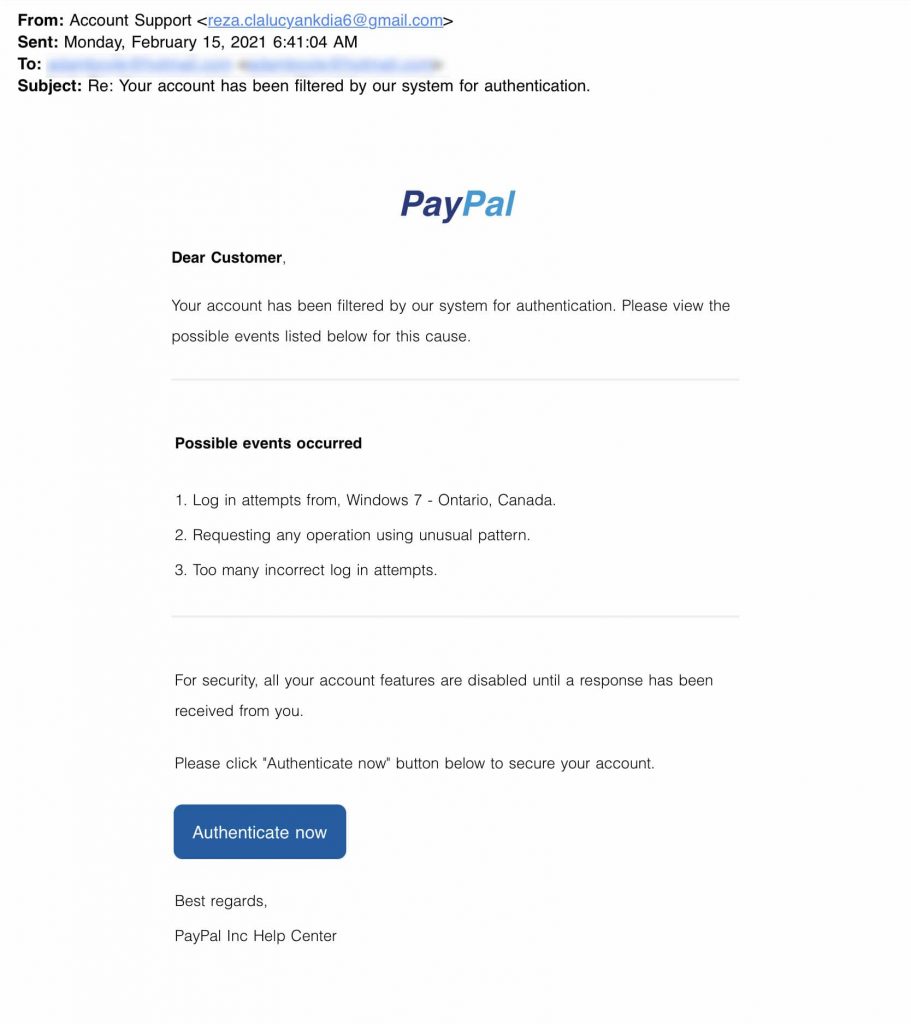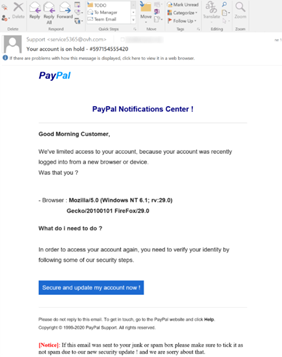What Is PayPal Email Phishing?
Hello everyone, we will discuss a topic that has been discussed a lot lately, namely PayPal phishing emails. Come on, let’s dig deeper into what it is and how to protect it.
PayPal phishing emails are email messages that appear legitimate as if they came from PayPal. However, these emails are actually sent by scammers to trick you into clicking on links or opening malicious attachments. Their goal is to steal your personal and financial information.
Typical characteristics of PayPal phishing emails are:
Urgent or threatening messages, asking you to take immediate action.
Unusual or suspicious links or attachments.
Spelling or grammatical errors.
The sender’s email address is unknown or does not match the official PayPal address.
If you receive a suspicious email in the name of PayPal, never click on the link or open the attachment. It is best to report the email to PayPal and delete it.
To protect yourself from PayPal phishing emails, you can do the following:
Always check the sender’s email address carefully.
Never click on a link or open an attachment in an email that you don’t trust.
If in doubt, contact PayPal directly through their official channels.
Use a strong password and enable two-factor authentication for your PayPal account.
Always keep your antivirus and security software up to date.
By following these precautionary steps, you can significantly reduce the risk of falling victim to a PayPal phishing email. Remember, always be alert and never rush to provide your personal or financial information in response to a suspicious email.
How to Recognize Phishing Emails and the Signs
Hello friends! Have you ever received an email from PayPal that made you suspicious? Well, there is a big possibility that it is a phishing email. Phishing is a fraudulent practice in which scammers send legitimate-looking emails or messages to trick victims into giving away their personal or financial information.
Well, PayPal is one of the common targets of these scammers. They created phishing emails that resembled official PayPal emails, complete with the same logo, colors and layout. But don’t be fooled, because there are several signs that can help you recognize PayPal phishing emails:
1. Suspicious Sender Email Address:
Genuine emails from PayPal will always be sent from their official email addresses, such as email protected or email protected While phishing emails are usually sent from similar but different email addresses, such as email protected or email protected
2. Unusual Greetings:
Real PayPal emails will usually greet you by name. Meanwhile, phishing emails often use generic greetings such as “Dear customer” or “PayPal user.”
3. Suspicious Links or Attachments:
Watch out for suspicious links or attachments in PayPal emails. If it redirects you to a different website or asks you to download a file, ignore it.
4. Request for Personal Information:
Phishing emails often ask you to provide personal information such as credit card numbers, bank account numbers, or passwords. PayPal will never ask for this information via email.
5. Unusual Urgency:
Phishing emails usually create a sense of urgency to get you to act quickly. They may state that your account will be closed or that unauthorized activity has been detected. Don’t panic, because PayPal will never pressure you to take immediate action.
If you receive a suspicious PayPal email, don’t click any links, don’t open attachments, and don’t provide any personal information. Report the email to PayPal via their official website or customer service.
Remember, PayPal will never ask for your personal information via email. If you are unsure about the authenticity of an email, it is always better to err on the side of caution and contact PayPal directly to verify it. By following these tips, you can protect yourself from phishing scams and keep your financial information safe.
Warning: PayPal Email Phishing Dangers That Threaten Your Account Security

In recent years, phishing (fraud) activity via email has increased drastically. One of the main targets of fraudsters is users of PayPal, a popular online financial service. PayPal email phishing is one of the most common and dangerous types of phishing, as it can compromise account security and cause significant financial loss.
What is PayPal Email Phishing?
PayPal email phishing is a type of phishing aimed at stealing login information and financial details from PayPal users. Scammers send emails that look like they come from PayPal, but are actually created to trick victims. The email usually contains a link that directs the victim to a fake website that resembles the official PayPal website.
How PayPal Email Phishing Works
Here’s how PayPal email phishing works:
- Scammers send emails to victims that look like they come from PayPal.
- The email contains a message claiming that there is a problem with the victim’s PayPal account, such as unusual activity or changes to account details.
- The email instructs victims to click on a provided link to fix the problem.
- The link directs victims to a fake website that resembles the official PayPal website.
- Victims are asked to enter login information and financial details, such as credit card numbers or passwords.
- Fraudsters then use the information to access the victim’s PayPal account and make unauthorized transactions.


How to Recognize Phishing PayPal Emails
Here are some ways to spot a phishing PayPal email:
- Check the sender’s email address : Make sure the sender’s email address is an official PayPal email address (paypal@paypal.com).
- Check the link provided : Make sure the link provided is an official PayPal link ( https://www.paypal.com ).
- Check sent messages : Make sure the message sent does not contain grammatical or spelling errors.
- Check whether the email contains threats : If the email contains threats, such as account closure or additional fees, then that is a sign that the email is phishing.
- Check to see if the email asks for login information : If the email asks for login information, then it is a sign that the email is phishing.

How to Prevent PayPal Email Phishing
Here are some ways to prevent PayPal email phishing:
- Use a strong password : Make sure you use a strong and unique password for your PayPal account.
- Enable two-factor authentication : Enable two-factor authentication to increase your account security.
- Check your account regularly : Check your account regularly to ensure there are no unauthorized transactions.
- Don’t click on unknown links : Don’t click on links that you don’t know or that don’t come from a trusted source.
- Use antivirus software : Use antivirus software to protect your computer from malware.
What to Do If You Fall Victim to PayPal Email Phishing?
If you fall victim to PayPal email phishing, here are some steps you should take:
- Change your password : Change your password immediately to prevent fraudsters from accessing your account again.
- Check your account : Check your account to ensure there are no unauthorized transactions.
- Contact PayPal : Contact PayPal to report the incident and request assistance.
- Check transaction reports : Check your transaction reports to ensure there are no unauthorized transactions.
Conclusion
PayPal email phishing is one of the most common and dangerous types of phishing. Don’t let you fall victim to PayPal email phishing. Make sure you recognize the signs of PayPal email phishing and prevent it by using strong passwords, two-factor authentication, and antivirus software. If you fall victim to PayPal email phishing, immediately change your password, check your account, and contact PayPal for help. By understanding the dangers of PayPal email phishing and taking preventative steps, you can protect the security of your account and avoid significant financial losses.
Tips to Avoid Phishing and Protect Your PayPal Account
PayPal email phishing is an online scam that targets PayPal users to steal their sensitive information, such as passwords, credit card numbers and banking details. These emails usually look like official communications from PayPal, complete with logos and designs similar to the original website.
However, these emails are fake and designed to redirect users to a fake website that looks identical to the real PayPal website. Once users enter their information on fake sites, fraudsters can access their PayPal accounts and steal money or commit other fraud.
To protect yourself from PayPal email phishing, it’s important to recognize the signs. Phishing emails typically:
Coming from an email address you don’t recognize
Using urgent or intimidating language, such as “Immediate action is required” or “Your account will be closed”
Asks you to click a link or open an attachment
Displays grammatical or spelling errors
Does not match the official PayPal branding (for example, the logo looks slightly different)
If you receive a suspicious email claiming to be from PayPal, do not click on any links or attachments. Instead, go to the PayPal website directly by typing the URL address in your browser’s address bar.
You can also check the authenticity of an email by checking the sender’s address. Official PayPal email addresses always end with “@paypal.com” or “@paypal-email.com”. If the sender address is different from this, the email is likely phishing.
In addition to recognizing the signs of PayPal email phishing, it’s also important to follow good security practices. This includes using strong passwords, enabling two-factor authentication, and updating your software regularly.
By following these tips, you can protect your PayPal account from phishing attacks and keep your sensitive information safe.






